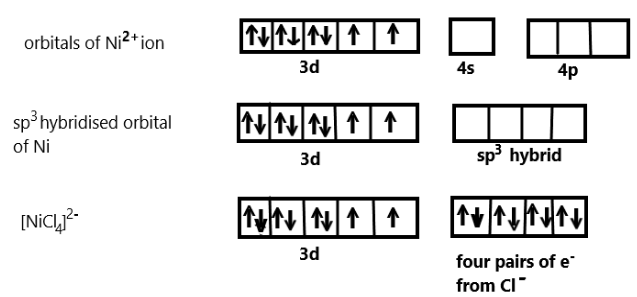
Answer
480k+ views
Hint:As we know that according to valence bond theory, the metal atom or ion can use
Complete step-by-step solution:We know that the Valence Bond Theory (VBT) states that the metal atom or ion use
In the given complex compound, we know that one
We also know that the compound contain Chloride ion which are actually weak ligand, so they cannot pair up the unpaired electrons of Nickel in

As we can see that
Therefore the correct answer is Tetrahedral geometry.
Note:Since this complex coordination compound Nickel tetrachloride possess two unpaired electrons, hence the compound is paramagnetic. Also remember when the weak ligand is present, there is no bonding between the central atom and the side atoms but when a strong ligand is present, bonding in d-orbital will take place and thus no unpaired electrons will be available which makes the compound diamagnetic.
Complete step-by-step solution:We know that the Valence Bond Theory (VBT) states that the metal atom or ion use
In the given complex compound, we know that one
We also know that the compound contain Chloride ion which are actually weak ligand, so they cannot pair up the unpaired electrons of Nickel in

As we can see that
Therefore the correct answer is Tetrahedral geometry.
Note:Since this complex coordination compound Nickel tetrachloride possess two unpaired electrons, hence the compound is paramagnetic. Also remember when the weak ligand is present, there is no bonding between the central atom and the side atoms but when a strong ligand is present, bonding in d-orbital will take place and thus no unpaired electrons will be available which makes the compound diamagnetic.
Recently Updated Pages
Master Class 12 Business Studies: Engaging Questions & Answers for Success

Master Class 12 English: Engaging Questions & Answers for Success

Master Class 12 Social Science: Engaging Questions & Answers for Success

Master Class 12 Chemistry: Engaging Questions & Answers for Success

Class 12 Question and Answer - Your Ultimate Solutions Guide

Master Class 11 Business Studies: Engaging Questions & Answers for Success

Trending doubts
Draw a labelled sketch of the human eye class 12 physics CBSE

a Tabulate the differences in the characteristics of class 12 chemistry CBSE

Which one of the following is a true fish A Jellyfish class 12 biology CBSE

Why is the cell called the structural and functional class 12 biology CBSE

Differentiate between homogeneous and heterogeneous class 12 chemistry CBSE

Write the difference between solid liquid and gas class 12 chemistry CBSE




